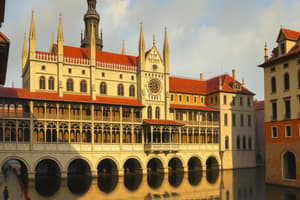Podcast
Questions and Answers
What is a defining feature of Romanesque architecture?
What is a defining feature of Romanesque architecture?
- Large glass windows
- Pointed arches
- Flying buttresses (correct)
- Thick walls (correct)
Which period does Gothic architecture primarily span?
Which period does Gothic architecture primarily span?
- 5th - 7th century
- 10th - 12th century
- 12th - 16th century (correct)
- 16th - 18th century
Which structural element was innovated in Gothic architecture to support walls?
Which structural element was innovated in Gothic architecture to support walls?
- Dome
- Columns
- Flying buttresses (correct)
- Vaults
What role did churches and cathedrals play in medieval society?
What role did churches and cathedrals play in medieval society?
How did the architecture of the medieval period reflect social structures?
How did the architecture of the medieval period reflect social structures?
Flashcards are hidden until you start studying
Study Notes
Introduction à l'architecture médiévale
- Période : environ 5e au 15e siècle.
- Caractéristiques : influences religieuses, féodales et militaires.
Styles principaux
-
Architecture romane (10e - 12e siècle)
- Éléments : arches en plein cintre, voûtes en berceau, murs épais.
- Exemples : abbayes, églises, châteaux.
-
Architecture gothique (12e - 16e siècle)
- Éléments : arcs brisés, voûtes sur croisée d'ogives, fenêtres à vitraux.
- Exemples : cathédrales (ex. Notre-Dame de Paris), églises.
Éléments architecturaux
-
Églises et cathédrales
- Importance religieuse et sociale.
- Construction souvent financée par l'Église ou les nobles.
-
Châteaux
- Utilisés pour la défense et la résidence.
- Éléments : tours, remparts, fossés.
Techniques de construction
- Utilisation de la pierre, briques et mortier.
- Développement de la voûte pour créer des espaces intérieurs plus grands.
- Innovations comme les arcs-boutants en architecture gothique pour soutenir les murs.
Influence de la société
- Réflexion des structures sociales : église, noblesse et paysannerie.
- Architecture comme symbole de pouvoir et de richesse.
Évolution régionale
- Variations selon les régions : style roman plus présent en France, gothique en Angleterre et en Italie.
- Adaptation aux conditions locales, matériaux disponibles et traditions.
Héritage
- Influence sur l'architecture moderne.
- Préservation de nombreux bâtiments historiques comme sites patrimoniaux.
Introduction to Medieval Architecture
- Period spans approximately from the 5th to the 15th century.
- Features a blend of religious, feudal, and military influences.
Main Styles
-
Romanesque Architecture (10th - 12th century)
- Characterized by round arches, barrel vaults, and thick walls.
- Common examples include abbeys, churches, and castles.
-
Gothic Architecture (12th - 16th century)
- Notable for pointed arches, ribbed vaults, and stained glass windows.
- Iconic structures include cathedrals, such as Notre-Dame de Paris.
Architectural Elements
-
Churches and Cathedrals
- Serve as significant religious and social centers.
- Often funded by the Church or nobles, reflecting their power.
-
Castles
- Function as defensive structures and residences.
- Key features include towers, ramparts, and moats.
Construction Techniques
- Predominant use of stone, bricks, and mortar in building.
- The vaulting technique allowed for larger interior spaces.
- Innovations like flying buttresses emerged in Gothic architecture to support walls.
Societal Influence
- Reflects social structures: the Church, nobility, and peasantry.
- Architecture symbolizes power and affluence of elites.
Regional Evolution
- Architectural styles vary by region: Romanesque more common in France, Gothic noticeable in England and Italy.
- Local adaptations made based on available materials and cultural traditions.
Heritage
- Medieval architecture has a lasting impact on modern architecture.
- Many historical buildings have been preserved as heritage sites, highlighting their cultural significance.
Studying That Suits You
Use AI to generate personalized quizzes and flashcards to suit your learning preferences.




